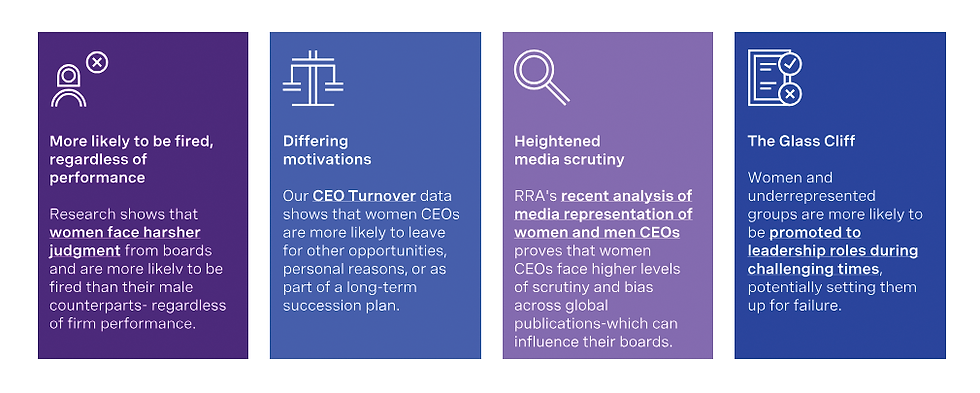Why Women CEOs Leave Sooner – and How Boards Can Help All CEOs Thrive
- Impact Boards EM

- Jun 12
- 2 min read

Women CEOs’ tenures are, on average, three years shorter than men’s. Russell Reynolds Associates has reported extensively on the common obstacles many women leaders face on their journeys to the top. Yet these obstacles don’t disappear once women make it there. This is perhaps best illustrated by data from RRA’s CEO Turnover Index, which found that, since 2018, women CEOs hold the role for an average of 5.2 years, while their male counterparts served for an average of 7.9 years – equating to men spending more than 50% longer in seat.
While there are many different reasons and contributing factors leading to a CEO’s departure, research shows that four overarching themes rise to the surface.

What can boards do to address the CEO tenure gap?
The board’s job isn’t over once a CEO has been successfully appointed. Organizations also need to ensure that overlooked roadblocks aren’t hindering a CEO’s ability to drive impact.
Consider the following:
In today’s volatile world, recognise that what makes a great CEO today is different and evolving
How can organisations identify leaders who both navigate change and keep their organisations steady? It comes down to executive potential. When boards focus on forward-looking competencies – like self-knowledge, systems thinking, resilience, and driving wider impact – they can both identify candidates who may have been otherwise overlooked, and ensure their current CEO is being judged in a fair and future-focused manner.
There’s no “one-size-fits-all” CEO
Boards spend a lot of time selecting the next CEO, but they often under-invest on helping the new CEO transition into the role, which is even more critical to CEO success, given the challenging and rapidly evolving environment for most companies. Boards need to ensure they are creating the optimal conditions for success for the next CEO, especially when a new CEOs doesn’t fit the stereotypical mould.
Proactively check biases when publicly discussing, internally evaluating, and before dismissing a CEO of any gender
Bias is a part of life. To counteract it, boards must ensure they are holding every CEO to the same performance standards and exhibiting consistent levels of public support for their organisation’s leadership, regardless of gender. If someone begins to question CEO performance, the board should refer to a consistent set of underperformance indicators.
Understanding organisational wiring is key to supporting your CEO
While boards can’t expressly dictate organisational practices, directors should work to build an accurate understanding of the organisation’s culture to help guide the CEO – especially while they’re new in seat. Our research finds that boards whose leaders actively seek a range of perspectives are 1.8 times more likely to feel they have the data needed to understand the company’s culture. Ultimately, it’s on the board to ensure that the conditions for success are in place.


